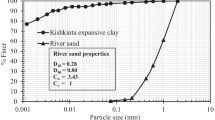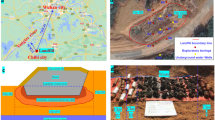Abstract
This paper aims to investigate the failure mechanism of compacted clay liner (CCL) impervious structures caused by the dry-wet cycles in a landfill final cover. Experimental research is performed on the evolution of permeability characteristics and microstructure of CCL with different initial compactness under repeated dry-wet cycles. The research results show that the effect of dry-wet cycle varies significantly on clays with different compactness. The permeability of the low-compacted clay (90 %) gradually decreases as the times of dry-wet cycles increases, while those of the high-compacted clay (98 %) gradually increases. A non-linear variation relationship between the permeability and dry-wet cycle times with compactness of CCL has been established. The tests and the prediction outcomes of the models both show that, after several dry-wet cycles, the permeability of all compacted clays are greater than 1 × 10−9 m/s, which can not meet the anti-seepage requirement of the landfill cover systems. The change in pore connectivity caused by the damage of soil structure under the wet-dry cycles is the main factor for the change of the permeability characteristics of CCL. We’ve determined the quantitative indexes (critical pore size) that can present the connectivity characteristic of the pore structure of clay, for which the evolution law under the dry-wet cycles is the same as that of the permeability of the CCL.
















Similar content being viewed by others
References
Albrecht BA, Benson CH (2001) Effect of desiccation on compacted natural clays. ASCE J Geotech Geoenviron Eng 1271:67–75
Benson CH, Daniel DE, Boutwell GP (1999) Field performance of compacted clay liners. J Geotech Geoenviron Eng ASCE 125(5):390–403
Boynton SS, Daniel DE (1985) Hydraulic conductivity tests on compacted clays. J Geotech Eng, ASCE 111(4):465–478
Brian AA, Benson CH (2001) Effect of desiccation on compacted natural clays. J Geotech Geoenviron Eng 127:67–75
Çelik B, Rowe K, Ünlü K (2009) Effect of vadose zone on the steady-state leakage rates from landfill barrier systems. Waste Manag 29:103–109
Drumm E, Boles D, Wilson G (1997) Desiccation cracks result in preferential flow. Geotech News Vancouver 15(1):22–25
Garcia-Bengochea I, Lovell CW, Altschaeffl AG (1979) Pore distribution and permeability of silty clay. ASCE J Geotech Eng Div 105:839–856
Griffiths FJ, Joshi RC (1989) Change in pore size distribution due to consolidation of clays. Geotechnique 39(1):159–167
Guilherme LML, Márcio DSSA, Horst MF (2004) Computational modelling of final covers for uranium mill tailings impoundments. J Hazard Mater 110:139–149
Hossein N, Farimah M (2008) Hydromechanical behaviour of an expansive bentonite/silt mixture in cyclic suction-controlled drying and wetting tests. Eng Geol 101:154–164
Hossein N, Farimah M (2010) Influence of suction cycles on the soil fabric of compacted swelling soil. Comptes Rendus Geosci 342:901–910
Jing H, Piet S (2003) Application of image analysis to assessing critical pore size for permeability prediction of cement paste. Image Anal Stereol 22:97–103
Katz AJ, Thompson AH (1986) Quantitative prediction of permeability in porous rock. Physical Rev B 34(1):8179–8181
Klein R, Baumann T, Kahapka E et al (2011) Temperature development in a modern municipal solid waste incineration (MSWI) bottom ash landfill with regard to sustainable waste management. J Hazard Mater B 83:265–280
Lapierre C, Leroueil S, Locat J (1990) Mercury intrusion and permeability of Louiseville clay. Can Geotech J 27:761–773
Leonards GA (1962) Engineering properties of soil, ch. 2, Foundation Engineering. McGraw-Hill Book Company, New York
Li JH (2009) Field experimental study and numercal simulation of seepage in saturated/unsaturated cracked soil. PhD thesis, Hong Kong University of Science and Technology, Hong Kong, China
Li JH, Zhang LM (2011) Connectivity of a network of random discontinuities. Comput Geotech 38:217–226
Linnéa A, Anthony CJ, Mark AK et al (2011) Permeability, pore connectivity and critical pore throat control of expandable polymeric sphere templated macroporous alumina. Acta Mater 59:1239–1248
Liu J, Xing F, Dong BQ (2007) Researchship between pore structure and permeability. China Concrete 12:35–38
Liu XL, Wang SJ, Wang EZ (2011) A study on the uplift mechanism of Tongjiezi dam using a coupled hydro-mechanical model. Eng Geol 117(1–2):134–150
Luiz FP, Osny OSB, Klaus R (2005) Gamma ray computed tomography to evaluate wetting/drying soil structure changes. Nucl Instrum Method Phys Res B 229:443–456
Neethirajan S, Jayas DS (2008) Analysis of pore network in three-dimensional (3D) grain bulks using X-ray CT images. Transp Porous Media 73(3):319–332
Omidi GH, Thomas JC, Brown KW (1996) Effect of desiccation cracking on the hydraulic conductivity of a compacted clay liner. Water Air Soil Pollut 89:91–103
Pires LF, Cooper M, Cássaro FAM (2008) Micromorphological analysis to characterize structure modifications of soil samples submitted to wetting and drying cycles. Catena 72:297–304
Rayhani MHT, Yanful EK, Fakher A (2007) Desiccation induced cracking and its effect on hydraulic conductivity of clayey soils from Iran. Can Geotech J 44:276–283
Rayhani MHT, Yanful EK, Fakher A (2008) Physical modeling of desiccation cracking in plastic soils. Eng Geol 97:25–31
Tyler SW, Wheatcraft SW (1992) Fractal scaling of soil particle-size distributions: analysis and limitations. Soil Sci Soc Am 56(1):362–369
Xu C, Li D, Huang L (2011) Relationship between permeability and microstructure of cement bentonite slurry concretion. J Tong-Ji Univ 39(6):820–824
Xue R, Hu RL, Mao LT (2006) Fractal study on the microstructure variation of soft soils in consolidation process. China Civ Eng J 39(10):87–91
Ye WM, Wan M, Chen B et al (2011a) Micro-structural behaviors of densely compacted GMZ01 bentonite under drying/wetting cycles. Chin J Geotech Eng 33(8):1173–1177
Ye WM, Qi ZY, Chen B et al (2011b) Mechanism of cultivation soil degradation in rocky desertification areas under dry/wet cycles. Environ Earth Sci 64:269–276
Zhang FZ, Chen XP (2011) Influence of repeated drying and wetting cycles on mechanical behaviors of unsaturated soil. Chin J Geotech Eng 32(1):41–46
Zhang HJ, Jenga DS, Seymourb BR et al (2012) Solute transport in partially-saturated deformable porous media: application to a landfill clay liner. Adv Water Resour 40:1–10
Acknowledgments
This research was supported by the National Basic Research Program of China (973 Program) (2012CB719802); “Interdiscipline and Cooperation” science and technology Innovation team, Chinese Academy of Sciences. The National Water Pollution Control and Management Science and Technology Major Projects of China (2012ZX07104-002); the Special Fund for Basic Research on Scientific Instruments of the National Natural Science Foundation of China (51279199,5079143) and Hubei Provincial Natural Science Foundation of China (2011CDA105).
Author information
Authors and Affiliations
Corresponding author
Rights and permissions
About this article
Cite this article
Wan, Y., Xue, Q. & Liu, L. Study on the permeability evolution law and the micro-mechanism of CCL in a landfill final cover under the dry-wet cycle. Bull Eng Geol Environ 73, 1089–1103 (2014). https://doi.org/10.1007/s10064-014-0604-x
Received:
Accepted:
Published:
Issue Date:
DOI: https://doi.org/10.1007/s10064-014-0604-x




